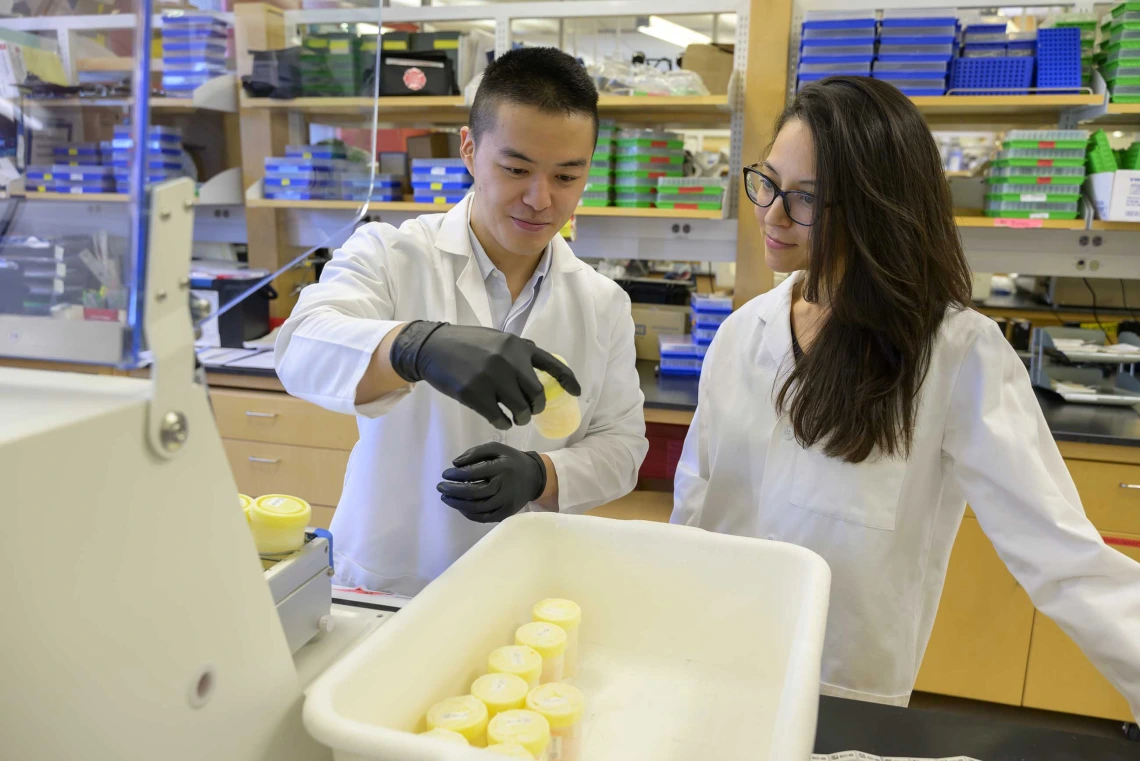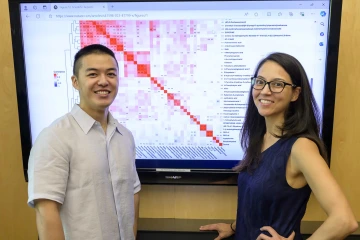Graduate student using data analysis to protect firefighters from cancer
The University of Arizona Health Sciences One Health initiative is funding Tuo Liu’s research into the mechanisms of cancer among firefighters.

Doctoral candidate Tuo Liu and Melissa Furlong, PhD, look at urine samples ready to be preprocessed in the laboratory of Jeff Burgess, MD, MPH.
Photo by Kris Hanning, U of A Health Sciences Office of Communications
The suffocating smell of smoke, the searing heat of flames, the adrenaline rush of battling a blaze – these are the hallmarks of a firefighter's life on the front lines. But beyond the immediate dangers of their profession lies another serious threat: cancer. The occupational exposure of firefighters is classified as carcinogenic by the International Agency for Research on Cancer, which may be linked to firefighters’ exposure to toxic substances released during fires.

As part of his doctoral research, Tuo Liu, MS, examines metabolomics and proteomics data to study health risks from environmental and occupational fire exposures.
Photo by Kris Hanning, U of A Health Sciences Office of Communications
Tuo Liu, MS, a doctoral candidate in environmental health sciences at the University of Arizona Mel and Enid Zuckerman College of Public Health, is on the front lines of research that attempts to better understand and mitigate the risks firefighters face. Liu’s research focuses on the complex interplay between environmental exposures and human health, particularly in the context of firefighting. He uses data generated from a working group led by Jeff Burgess, MD, MS, MPH, director of the Center for Firefighter Health Collaborative Research and professor at the Zuckerman College of Public Health.
“The challenges firefighters face are very intense and pressing,” Liu said. “They have a dangerous job, and they are exposed to a lot of other health risks just for doing that job. For me, it is a practical problem I want to help solve.”
In 2023, the U of A Health Sciences One Health initiative awarded Liu with funding to study the effects of urban-wildland fire exposure on firefighters. Liu’s work investigates the molecular intricacies of the human body, seeking to understand the mechanisms by which fire exposure may lead to cancer.
His research utilizes big data and cutting-edge techniques including metabolomics, a field that studies the small molecules produced during the body’s metabolic processes. By analyzing urine samples from firefighters before and after battling blazes, Liu can identify changes in these metabolites to uncover clues about the impact of fire exposure on the body.
Unraveling molecular mysteries
The human body is a complex network of chemical reactions that are constantly breaking down substances and building new ones. The byproducts of these reactions are called metabolites, and they provide a snapshot of the body’s internal state.

A link between fire exposure and cancer has been established, but researchers are still trying to define exactly why firefighters are at an elevated risk for cancer.
Photo by Virojt Changyencham via Getty Images
By studying changes in metabolite levels after fire exposure, scientists can gain insights into how the body responds at the molecular level, potentially providing early indicators of health risks for firefighters long before cancer or other diseases manifest.
“When we look at dramatic changes in the metabolome, or the collection of all of these metabolites, in response to fires, we have seen changes in a few different metabolic pathways that are consistent from study to study,” said Melissa Furlong, PhD, Liu’s research mentor and an assistant professor in the Department of Community, Environment and Policy at the Zuckerman College of Public Health. “We’re starting to think that maybe these are actually critical pathways by which some of the health effects are occurring, which is the foundation for several of the studies we are conducting.”
Furlong says metabolomics is one of the ways the identification of these crucial metabolic pathways is made possible. Metabolomics offers unique advantages due to the rapid changes metabolites undergo in response to various factors, including diet, exercise, medication and, most importantly for Liu’s work, environmental exposures such as those encountered by firefighters.
By analyzing metabolic changes, researchers hope to identify early signs of health effects before they manifest clinically. This could allow for early interventions and even preventive measures, a critical goal in protecting the health and well-being of firefighters.
Identifying molecular changes
Liu’s One Health-funded study focuses on wildland-urban interface fires, which occur in the zone where human development meets wildland vegetation. These fires present unique challenges due to the combustion of natural and synthetic materials, leading to a complex mixture of smoke and pollutants.
“The difference between wildland-urban interface and structure household fires will be that wildland-urban interface fires include combustion of biomass, trees and grass, as well as structures,” Liu explained. “Household fires might have carpet or maybe computers and electronics that introduce a different set of exposure, a different set of chemicals.”
Understanding these differences is crucial for developing targeted interventions to protect firefighters. Liu hopes his research will lead to the development of better protective gear, such as masks and filters specifically designed to block the harmful chemicals identified in his studies.
Using firefighter urine samples collected in the study, Liu’s research revealed significant changes in certain metabolites of firefighters who battled wildland-urban interface fires, suggesting potential pathways linked to cancer development. The findings, which are being submitted for publication, may help Liu and other researchers design studies to further investigate the specific metabolite changes.

A correlation heatmap shows Liu and Furlong important metabolites detected in urine samples from firefighters, thus highlighting connections to other metabolites that may warrant further investigation.
Photo by Kris Hanning, U of A Health Sciences Office of Communications
“Hopefully, the short-term goal will be better prevention,” Liu said. “The long-term goal will be that we help reduce the cancer risk.”
Liu also works with mouse models to gain a deeper understanding of the effects of fire exposure by isolating the impact of smoke exposure from other factors, such as diet or exercise, which can also influence metabolite levels.
“This allows us to see specifically what effect exposure has in the body,” Liu said. “This information is valuable not only for humans, but also for animals that are exposed to wildland-urban interface fires, too.”
A broader impact
Liu believes the novel technologies and techniques he and other researchers are utilizing will make a positive impact on firefighters in the future. He envisions a future where firefighters can perform their duties with a significantly reduced cancer risk.
The research has implications for public health as well, according to Furlong. Many of the chemicals released during fires are also present in the environment. By understanding the mechanisms by which these exposures affect the body, Liu’s work can contribute to a better understanding of environmental health risks for everyone.
“This is really relevant for non-firefighters, too,” Furlong said. “Everything that we are finding out about exposure pathways, the relevant exposures and the increased risk for cancer is important to the general population. We are all exposed to these things, just not always in the concentrated form that firefighters are experiencing.”
Experts
Melissa Furlong, PhD
Assistant Professor, Department of Community, Environment & Policy, Mel and Enid Zuckerman College of Public Health
Jeff Burgess, MD, MS, MPH
Professor, Department of Community, Environment and Policy, Mel and Enid Zuckerman College of Public Health
Director, Center for Firefighter Health Collaborative Research
Member, Cancer Prevention and Control Program, U of A Cancer Center
Member, BIO5 Institute
Related Stories
Research shows altered regulation of genes linked to prostate cancer among firefighters
$3.8M grant will fund study of firefighter risks, interventions in wildland-urban blazes
Study aims to reduce firefighter cancer risk
New center leads collaborative research to improve firefighter health
Research collaboration informs international classification of firefighting as carcinogenic
Study shows potential epigenetic basis for increased health risks in firefighters
Contact
Blair Willis
U of A Health Sciences Office of Communications
520-419-2979, bmw23@arizona.edu

